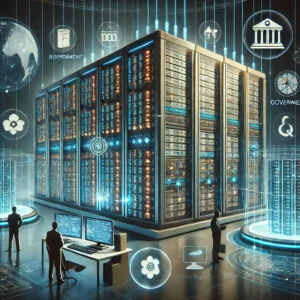1. Mainframe Computers
What is a Mainframe?
A Mainframe computer is a large, powerful computer that can handle and process huge amounts of data very quickly. They are used by big organizations, like banks, governments, and large companies, to run their daily operations and store huge amounts of data.

How Does a Mainframe Work?
- High-Speed Processing: Mainframes can process millions of transactions and data requests every second.
- Multiple Users: They can serve many users at the same time. Think of a mainframe as a giant hub where many people can access and use data without slowing it down.
- Reliability: Mainframes are built to be extremely reliable and work continuously without crashing or breaking down.
Where Are Mainframes Used?
- Banks: For processing thousands of transactions every second.
- Government Agencies: To manage records and process data on a national scale.
- Large Corporations: To handle data like customer information, inventory, and payroll.
Why Are Mainframes Important?
- They can handle large volumes of data.
- Fast and secure: They are critical for systems that require lots of data processing and maximum security.
2. Supercomputers
What is a Supercomputer?
A Supercomputer is a specialized, ultra-powerful computer designed to perform extremely complex calculations at super-fast speeds. They are the most powerful type of computer and are used for tasks that need an immense amount of computing power, like scientific research, weather prediction, and space exploration.
How Does a Supercomputer Work?
- High Processing Power: Supercomputers have thousands of processors working together to complete tasks very quickly.
- Parallel Computing: They can perform many operations at once (called parallel processing) to solve massive problems that regular computers can’t handle.
- Advanced Cooling: Supercomputers generate a lot of heat because they are so powerful, so they need special cooling systems to keep them from overheating.
Where Are Supercomputers Used?
- Weather Forecasting: To predict hurricanes, tornadoes, and other weather patterns.
- Scientific Research: Used for research in fields like genetics, medicine, and physics.
- Space Exploration: For complex simulations, like planning space missions or understanding the universe.
Why Are Supercomputers Important?
- They can solve complex problems and run simulations that are critical for research, like studying climate change or testing nuclear reactions.
- Supercomputers help us make important discoveries in science and technology by processing data much faster than other computers.
3. Personal Computers (PCs)
What is a Personal Computer?
A Personal Computer (PC) is the type of computer that most people use every day. They are designed for individual use and are much smaller and more affordable compared to mainframes and supercomputers. PCs can be either desktops or laptops.
How Does a Personal Computer Work?
- Basic Computing: Personal computers are built to handle everyday tasks, such as word processing, web browsing, playing games, and watching videos.
- Single User: Unlike mainframes, which serve many users at once, PCs are used by one person at a time.
- Affordable: They are much cheaper and available for home use or small businesses.
Where Are Personal Computers Used?
- Home: For personal tasks like browsing the internet, watching movies, playing games, or working.
- Offices: For tasks like writing documents, creating spreadsheets, and sending emails.
- Schools: Used by students and teachers for research, homework, and learning.
Why Are Personal Computers Important?
- Everyday Tasks: Personal computers allow us to do almost everything in daily life, from communication (email) to entertainment (movies, games) and productivity (work, study).
- Affordable and Accessible: They are much cheaper and available to most people, making them essential for both work and leisure.
Comparison of Mainframes, Supercomputers, and Personal Computers:
| Type of Computer | Mainframes | Supercomputers | Personal Computers (PCs) |
|---|---|---|---|
| Size | Very large, often take up entire rooms | Extremely large, need special buildings | Small, can fit on a desk or be portable (laptops) |
| Purpose | Large-scale data processing for organizations | Solve complex scientific and engineering problems | Everyday personal tasks (work, entertainment, etc.) |
| Speed/Power | Powerful, but not as fast as supercomputers | Extremely powerful, fast at complex calculations | Moderate power, sufficient for everyday use |
| Users | Many users simultaneously (e.g., in a company) | Used by scientists, engineers, and researchers | Used by individuals for personal or office use |
| Cost | Very expensive and requires specialized environments | The most expensive type of computer | Affordable and widely available |
| Examples of Use | Bank transactions, government data management | Weather forecasting, space research, scientific simulations | Web browsing, gaming, writing, social media |
In Summary:
- Mainframes are huge, powerful computers used by large organizations for processing large amounts of data and running multiple systems at once.
- Supercomputers are ultra-powerful machines used for tasks that need immense computational power, like scientific simulations, weather prediction, and space exploration.
- Personal Computers (PCs) are small, affordable computers used by individuals for daily tasks like browsing the web, playing games, and working on documents.
Each of these types of computers plays an important role in modern society, depending on the needs of the user—whether it’s handling massive data, solving complex problems, or helping you with everyday tasks.











